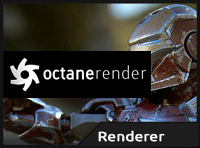
OctaneRender is an unbiased rendering application featuring real-time processing based only on the GPU (graphics processing unit). OctaneRender was originally developed by a New Zealand company called Refractive Software and the development of the renderer was later taken over by OTOY. OctaneRender is the first GPU based unbiased renderer released to the public. It uses the graphics card to calculate all measures of light, reflection and refraction. It runs only on NVidia’s GPUs and takes advantage of the CUDA technology and it’s incompatible with other video cards by other vendors. Is a true GPU based engine, not a hybrid CPU/GPU, nor a CPU based engine that was modified with GPU acceleration. Since a CPU adds a negligible speedup to the total rendering speed, having your CPU free for other tasks while rendering with OctaneRender allows you to use your system for other tasks while rendering.
OctaneRender was for a long time in a beta testing stage where the developers were tightly communicating with the artists testing the renderer and using the feedback for improving and fixing it. Now after the beta testing of OctaneRender is over we got the opportunity to review and compare the first official release of OctaneRender among other renderers on the market to determine if the technology of GPU based rendering can really bring the speed and quality in „seconds“.
OctaneRender 1.0 specification & features
Technology & Performance
- Physically based / Spectral Light Transport
- Unbiased and Direct Lighting / Ambient Occlusion
- Custom Sampling Algorithm (Custom MLT-like implementation)
- Multiple GPU Support
- Geometry Instances
- Pause / Resume render
- Built-in Firefly removal tool
Lights & Environment
- Spectral Sun / Sky daylight with real-time location / date control system
- Spectrum or HDRI environment lighting
- Customizable texture and blackbody spectra emissions from geometry with controls for temperature, power (watts), distribution, efficiency
- Support for IES light files
Materials & Shading
- Physically based material models
- Bump and normal mapping
- Opacity / Alpha mapping
- Transmission, absorption and scattering
- Map able Thin Film Coatings
- Null material and mix/stacking of materials and layers
- IOR and Chromatic dispersion for specular materials
- Access to LiveDB Material Database to quickly add community submitted materials to current scene
Supported Platforms
- Windows 32 and 64 bit
- Linux 64 bit
- Mac OS X 10.5+
- Autodesk 3D Studio Max
- Autodesk Maya
- Smith Micro's Poser (open, licensed beta)
OctaneRender 1.0 overview
OctaneRender operates as a stand-alone application but also as a plug-in with popular 3D modelling software like Autodesk 3ds Max, Autodesk Maya and Smith Micro Poser and will soon be available for Autodesk Softimage, Autodesk AutoCAD, Daz3D Daz Studio, Newtek Lightwave and Maxon Cinema4D. The tightly integrated plug-ins deliver OctaneRender's incredible speed and quality right in the viewport of the 3D application, allowing artists to interactively change lights, camera, materials, exposure, depth of field, other effects and object placement and immediately see the rendered result with final quality. This basically means that the viewport on the screen is also the final render and it’s changing according to the artist’s changes. This revolutionary real-time workflow is a key change for animators and other 3d artists and was possible by using GPU as the main calculating unit instead of CPU as other renderers. OctaneRender is a fully physically based, unbiased render engine. It cuts no corners and all computations are done at the same accuracy as traditional CPU unbiased render engines. With the current technology OctaneRender can produce final images 10 to 50 times faster than CPU unbiased render engines, or even more with multiple GPUs. The stand-alone version of OctaneRender allows you to import the scene from almost any 3D application using the *.obj format and even preserve the materials ids set-up in the 3D application. There are also unofficial scripts which can help you to export the scene preserving even the lightning and cameras and automatically start the OctaneRender. Moreover OctaneRender allows you to export the final renders in LDR and HDR formats, and can be easily implemented into different pipelines and workflows. We were mainly reviewing the integration inside Autodesk 3ds Max and this review is also focused on it.
Render engine
- Physically based / Spectral Light Transport
- Unbiased and Direct Lighting / Ambient Occlusion
- Custom Sampling Algorithm (Custom MLT-like implementation)
- Multiple GPU Support
- Geometry Instances
- Pause / Resume render
- Built-in Firefly removal tool (note: available in OctaneRender stand-alone)
- "Deep Channel" kernel mode to provide renders for geometric normals, shading normals, z-depth, material ID, UV co-ordinates
